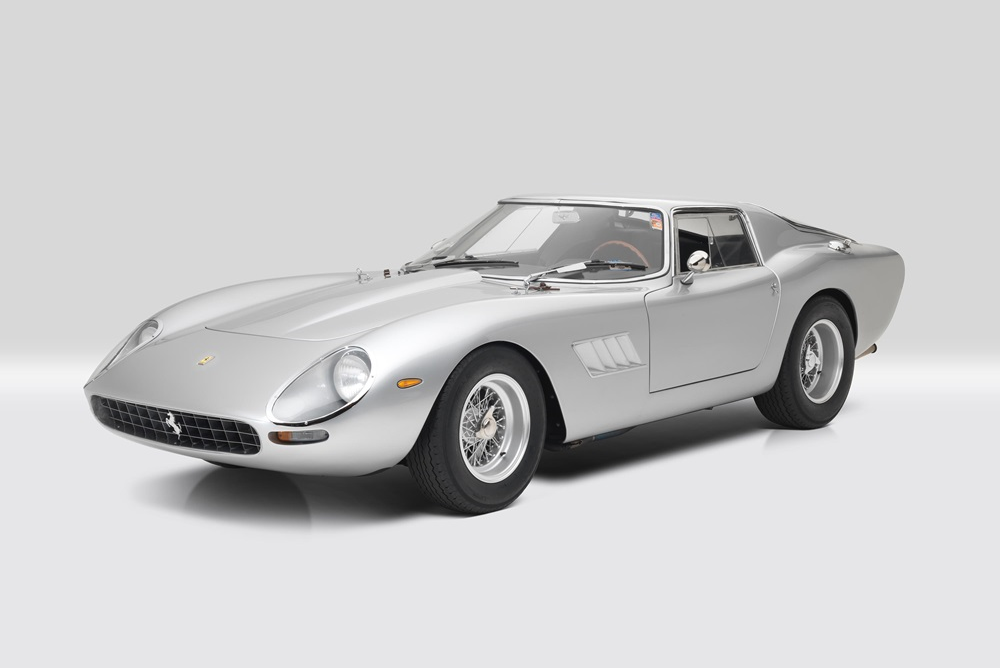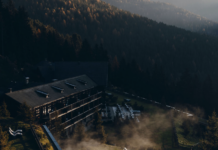Delivered new as a Pinin Farina-bodied coupé, Ferrari 250 GT chassis number ‘1717 GT’ was re-bodied in 1966 by Piero Drogo’s Carrozzeria Sports Cars. Born in Argentina in 1926, Piero Drogo followed his friend and compatriot Juan Manuel Fangio to Europe after WWII, intent on continuing his motor racing career. He appears eventually to have realised that his talents would be better employed elsewhere, and in the early 1960s set up Carrozzeria Sports Cars in Modena with partners Lino Marchesini and Celso Cavallieri to undertake car design and coachbuilding.

The company concentrated mainly on re-bodying Ferraris (usually 250 GTs) but CSC’s creations are now widely acknowledged as equalling the best in original coachwork of the period. Now commonly referred to as ‘Drogo’, the company also specialised in improving the aerodynamics of competition Ferraris, its trademark being an altered and extended nose.
CSC’s customers included, among others, Scuderia Ferrari, Giotto Bizzarrini, Iso, Scuderia Serenissima, ASA, NART, and Écurie Francorchamps. Despite this most impressive roll call of clients, CSC was in financial difficulties by 1971 and in December of that year was declared bankrupt. Piero Drogo died in a road accident in 1973 driving, naturally enough, a Ferrari.
As mentioned above, CSC’s favoured basis for its conversions was the ubiquitous Ferrari 250 GT. The introduction of its forerunner, the 250 Europa, had heralded a significant change in Ferrari’s preferred coachbuilder; whereas previously Vignale had been the most popular carrozzeria among Maranello’s customers, from now on Pinin Farina (later Pininfarina) would be Ferrari’s number one choice. Pinin Farina’s experiments eventually crystallised in the new Ferrari 250 GT road car that was first displayed publicly at the Geneva Salon in March 1956.

The styling of the Geneva show car – chassis number ‘0429GT’ – was influenced by Pinin Farina’s Superamerica. With the Series 2 variant of the 410 Superamerica, Ferrari had switched from a 2,800mm wheelbase to one of 2,600mm, and this shorter dimension would be used for all members of the 250 GT family from the Europa GT onwards, with the exception of the competition orientated SWB and GTO models. As well as the handling advantages conferred by the shorter wheelbase, the 250 GT was equipped as standard with the more compact Colombo-designed 3.0-litre V12 engine, which replaced the Superamerica’s bulkier Lampredi unit. However, Pinin Farina was not yet in a position to cope with the increased workload – construction of its new factory at Grugliasco had only just started – resulting in initial production being entrusted to Carrozzeria Boano after Pinin Farina had completed a handful of prototypes.
 The 250 GT represented a significant departure for Ferrari: driver and passenger comfort were taken seriously for the first time, the interior was more luxurious, seats were broader and there was less noise intrusion. By this time there was also synchromesh in the gearbox which, combined with a softer ride and light steering, was exactly what was expected by the increasingly important North American market. Pininfarina’s 250 GT Coupé would turn out to be a major commercial success for Maranello, with a total of 350 sold between 1958 and 1960, significantly more than any preceding model.
The 250 GT represented a significant departure for Ferrari: driver and passenger comfort were taken seriously for the first time, the interior was more luxurious, seats were broader and there was less noise intrusion. By this time there was also synchromesh in the gearbox which, combined with a softer ride and light steering, was exactly what was expected by the increasingly important North American market. Pininfarina’s 250 GT Coupé would turn out to be a major commercial success for Maranello, with a total of 350 sold between 1958 and 1960, significantly more than any preceding model.
Ferrari 250 GT ‘1717’ entered Pinin Farina’s Turin factory on 22nd December 1959 and was completed with coupé coachwork on 22nd February 1960. The original colour scheme was Grigio Scuro (Dark Grey) with blue Connolly leather/vinyl interior. In April 1960 the car was delivered to the official Ferrari dealer Garage de Montchoisy in Geneva, Switzerland. Later that same year the Ferrari was sold to its first owner, a resident of Lausanne, Switzerland, and registered as ‘VD 40283’. In November 1964, ‘1717’ was serviced at the Ferrari factory’s Assistenza Clienti facility in Modena, the odometer reading being 54,489 kilometres.

In 1965, the Ferrari was crashed in Switzerland and sent back to Modena, Italy where the chassis was repaired and shortened by William Vaccari. Vaccari e Bosi SRL was founded by Enzo Ferrari and William Vaccari for making chassis frames for Ferrari SpA. Later they worked for Lamborghini, Maserati, Pininfarina etc. The rebuilt car was then completely re-bodied by Drogo’s Carrozzeria Sports Cars with particularly elegant and aerodynamic coupé coachwork, and was finished in October 1966.
The Ferrari was next owned by Gerard Delgado, a Frenchman living in Barcelona and Mallorca, Spain, and was crashed in France at some time during the 1970s. Having been partially restored, ‘1717 GT’ was despatched in the 1980s to Franco Sbarro’s garage in Yverdon, Switzerland where additional repairs were carried out and the car painted red. Additional vents aft of the front wheelarches were added, and the front grille modified. Later in the 1980s the Ferrari was sold back to Switzerland, in Lausanne, passing into the custodianship of Pierre De Siebenthal, where it was registered as ‘VD 16543’.
In March 1985, ‘1717’ was displayed at the 55th annual Geneva Motor Show, and in June of that year was raced at the Mont Ventoux historic hill climb, where it appeared painted in red. In September ’85 the Ferrari participated in the ’80 Anni di Sport’ event held at Modena (competitor number ‘228’). In October 1987 ‘1717’ took part in Ferrari’s 40th Anniversary Meeting at Imola, Italy driven by an Italian named Mario Caliceti (competitor number ‘177’). At that time the car was on Swiss license plates and still owned by Pierre De Siebenthal (see Ferrari 40 by Giulio Schmidt, pages 40 and 64).
In 1988 Pierre de Siebenthal sold ‘1717’ to José Segimon of Madrid, Spain, who entered the Ferrari in several historic races including the Carrera des Dolomites where he finished 3rd overall. ‘1717’ next changed hands in July 2000 when it was sold at a UK auction to David Morrison; the Ferrari was registered on UK plates as ‘FAS 881’. Later that year the car was repainted in silver-grey metallic with a contrasting blue longitudinal stripe.


In June 2001, the Ferrari was driven during the Kinnerton Confectionery Test Day at Rockingham Motor Speedway by David Clark of historic competition car specialists, Taylor & Crawley. That year’s Goodwood Revival Meeting saw ‘1717’ driven by the American Duncan Dayton in the RAC Tourist Trophy Celebration race (competitor number ’16’). The car was also raced by David Clark and the former Formula 1 driver Stefan Johansson.
In 2003, the Ferrari was sold to Rudolfo Junco de la Vega of Monterrey, Nuevo Leon, Mexico, for whom it was stored by Steven Tillack at his premises in Redondo Beach, California. Still owned by Junco, ‘1717’ was seen in the paddock at the 31st Annual Rolex Monterey historic races at Laguna Seca in 2004, and in 2017 was displayed by Tillack at Rétromobile in Paris.
Subsequently the Ferrari was sold to the current owner in Belgium, who raced it in 2018 at the Dix Mille Tours du Castellet, Grand Prix de l’Âge d’Or in Dijon, and Imola Classics. Not long after, the car was overhauled by Corrado Patella rebuilding the rest of the mechanicals, while the engine was entrusted to renowned Ferrari specialist Piet Roelofs in the Netherlands. The car was painted in silver-grey metallic with blue accents; importantly, the front grille was returned to the original Drogo specifications. The layout of the dashboard instruments, however, had been changed since Drogo’s time, as had the interior upholstery. In September 2022, ‘1717’ was displayed at the ‘Ferrari 75 Years’ exhibition held at the Autoworld Museum in Brussels, Belgium, before appearing on the circuit during the prestigious Lavant Cup at the Goodwood Revival 2023, a tribute to the 50’s/60’s race of the same name. The car, driven by Christophe Van Riet, finished 8th in the race, surrounded by Ferraris including the 250 LM, 330 GTO, 250 GTO, 250 GT ‘Breadvan’ and 250 SWB!

The car was recently resprayed in the original Ferrari silver colour (ref. 101) and no longer has the non-original vents by the rear wheelarches. The engine currently fitted has been prepared by Piet Roelofs and has six carburettors, dry-sump lubrication, and a five-speed gearbox, so is to approximately 250 GTO specification. The bodywork now is as original, as is the interior, which features black leather seats with dark grey velour centres, original instruments, and a wood-rim steering wheel. The car also benefits from four new tyres.
Prepared to fast road specification and easily adaptable to most serious forms of competition, the car will be delivered with a roll cage alongside. The original matching numbers engine, ‘1717GT’, will be delivered to the successful purchaser together with the original roll bar. The car also comes with a substantial history file of correspondence, bills, registration documents, restoration photographs, etc.
Arguably one of the finest examples of bespoke Italian coachbuilding from the 1960s, this handsome and highly individual Ferrari 250 GT possesses looks rivalling those of a 250 GTO.










